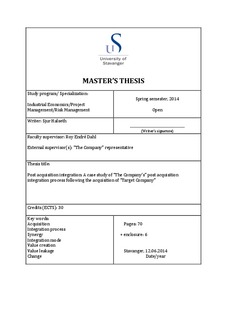| dc.contributor.author | Halseth, Sjur | |
| dc.date.accessioned | 2014-10-07T08:50:43Z | |
| dc.date.available | 2014-10-07T08:50:43Z | |
| dc.date.issued | 2014-06-12 | |
| dc.identifier.uri | http://hdl.handle.net/11250/223232 | |
| dc.description | Master's thesis in Industrial economics | nb_NO |
| dc.description.abstract | A lot of focus regarding M&A is aimed towards its high failure rates and many studies concludes that this often is a result of poor post M&A integration of the acquired firm. This thesis attempts to shed light on this problem and identify reasons to why so many acquisitions fail to integrate the acquired firm, realize synergies and thus create additional value.
In the quest to provide some answer to this existing problem a case study of a post acquisition integration process performed by a company that possesses a great deal of experience in the field is conducted. The database, which is analyzed and used to evaluate the integration process, is derived from interviews and a survey of employees from the acquired company as well as a theoretical framework built on research relevant for the subject.
The thesis investigates how well this company performed the post acquisition integration based on theoretical guidelines and if desired synergies were achieved. The results reveal that they have been successful in some areas, while other areas of integration have been less successful. Especially the employee integration, which is considered the foundation for successful task integration was well performed. In this phase of integration actions to secure a positive atmosphere among the employees is key. The results also revealed that the acquiring company failed to provide training and assistance in order to handle some of the change initiatives as well as the measurement and progress monitoring of theses were absent. Moreover, the thesis suggests that the main reason for these mistakes might stem from lack of identification or misidentification of value leakage sources.
The analysis of the acquisition background and the following integration show that the mode of the acquisiton as well as how the merging companies relate internally and externally pre acquisition determine to a large extent the level and speed of integration required to succeed.
Lastly, the case study indicates that synergy realization does not necessary depend on well-performed integration, but it determine to what extent the synergies get utilized. In this case the synergy possibilities emerged from strategies prior to the integration, and the integration it self was a measure to utilize these possible benefits and avoid value leakage. | nb_NO |
| dc.language.iso | eng | nb_NO |
| dc.publisher | University of Stavanger, Norway | nb_NO |
| dc.relation.ispartofseries | Masteroppgave/UIS-TN-IØRP/2014; | |
| dc.rights | Attribution 3.0 Norway | * |
| dc.rights.uri | http://creativecommons.org/licenses/by/3.0/no/ | * |
| dc.subject | industriell økonomi | nb_NO |
| dc.subject | industrial economics | nb_NO |
| dc.title | Post acquisition integration: a case study of “The Company’s” post acquisition integration process following the acquisition of “Target Company” | nb_NO |
| dc.type | Master thesis | nb_NO |
| dc.subject.nsi | VDP::Social science: 200::Economics: 210 | nb_NO |

